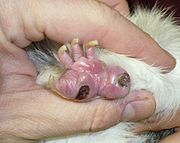.gif)
Bumblefoot (infection)
Encyclopedia

Bacteria
Bacteria are a large domain of prokaryotic microorganisms. Typically a few micrometres in length, bacteria have a wide range of shapes, ranging from spheres to rods and spirals...
l infection
Infection
An infection is the colonization of a host organism by parasite species. Infecting parasites seek to use the host's resources to reproduce, often resulting in disease...
and inflammatory
Inflammation
Inflammation is part of the complex biological response of vascular tissues to harmful stimuli, such as pathogens, damaged cells, or irritants. Inflammation is a protective attempt by the organism to remove the injurious stimuli and to initiate the healing process...
reaction on the feet of bird
Bird
Birds are feathered, winged, bipedal, endothermic , egg-laying, vertebrate animals. Around 10,000 living species and 188 families makes them the most speciose class of tetrapod vertebrates. They inhabit ecosystems across the globe, from the Arctic to the Antarctic. Extant birds range in size from...
s and rodent
Rodent
Rodentia is an order of mammals also known as rodents, characterised by two continuously growing incisors in the upper and lower jaws which must be kept short by gnawing....
s. This infection is much more likely to occur in captive animals than in those in the wild.
Bumblefoot on birds of prey
Bumblefoot is, perhaps, the largest cause of referral of birds of prey to a veterinary surgeon. Bumblefoot on birds of prey can be put into three broad types of the infection;In the first type, a small reddened area, or sometimes a small shiny patch, can be seen on the foot. This is mostly caused by inappropriate perching (or perching for too long), or, less likely, by badly fitted furniture, such as jesses
Jesses (falconry)
Jesses are thin straps, traditionally made from leather, used to tether a hawk or falcon in falconry. They allow a falconer to keep control of a bird while it is on the glove or in training, and allow a bird to be secured on a perch outside of its aviary...
that are too small. To treat this type, one must change the fault in the husbandry, fly the bird regularly, and apply hemorrhoid
Hemorrhoid
Hemorrhoids or haemorrhoids , are vascular structures in the anal canal which help with stool control. They become pathological or piles when swollen or inflamed. In their physiological state they act as a cushion composed of arterio-venous channels and connective tissue that aid the passage of...
cream to the affected foot.
The second type is more serious, where some penetration has occurred. While treatment for the first type will help, it is likely that the bird will require antibiotic
Antibiotic
An antibacterial is a compound or substance that kills or slows down the growth of bacteria.The term is often used synonymously with the term antibiotic; today, however, with increased knowledge of the causative agents of various infectious diseases, antibiotic has come to denote a broader range of...
s as well.
The third type involves the bird having severe distortion of the contours of the foot and/or the toes, resulting from the Bumblefoot causing considerable damage in the foot.
Bumblefoot in poultry and waterfowl
Bumblefoot is a common infection for domesticated poultryPoultry
Poultry are domesticated birds kept by humans for the purpose of producing eggs, meat, and/or feathers. These most typically are members of the superorder Galloanserae , especially the order Galliformes and the family Anatidae , commonly known as "waterfowl"...
and waterfowl
Waterfowl
Waterfowl are certain wildfowl of the order Anseriformes, especially members of the family Anatidae, which includes ducks, geese, and swans....
such as chicken
Chicken
The chicken is a domesticated fowl, a subspecies of the Red Junglefowl. As one of the most common and widespread domestic animals, and with a population of more than 24 billion in 2003, there are more chickens in the world than any other species of bird...
s and duck
Duck
Duck is the common name for a large number of species in the Anatidae family of birds, which also includes swans and geese. The ducks are divided among several subfamilies in the Anatidae family; they do not represent a monophyletic group but a form taxon, since swans and geese are not considered...
s. Due to constant walking on hard, rough, or sharp surfaces, birds can develop small wounds on the bottom of their feet. These wounds are very susceptible to infection by Staphylococcus aureus
Staphylococcus aureus
Staphylococcus aureus is a facultative anaerobic Gram-positive coccal bacterium. It is frequently found as part of the normal skin flora on the skin and nasal passages. It is estimated that 20% of the human population are long-term carriers of S. aureus. S. aureus is the most common species of...
, bacteria which can cause bumblefoot in poultry and waterfowl. Treatment often requires opening the wound to drain the pus and antibiotic treatment and local application of pyodine as local dressing.
Bumblefoot in rodents
Bumblefoot in rodents is caused by wire and mesh flooring and/or wheels. The only rodent not affected is the gerbilGerbil
A gerbil is a small mammal of the order Rodentia. Once known simply as "desert rats", the gerbil subfamily includes about 110 species of African, Indian, and Asian rodents, including sand rats and jirds, all of which are adapted to arid habitats...
, which has tougher feet and can safely walk on mesh and wire.
Etymology
Bumblefoot is so named because of the characteristic "bumbles" or lesions as well as swelling of the foot pad symptomatic of an infection. Topical antiseptics such as Blue-Kote in addition to oral or injected antibiotics may be used to combat the infection, which if left untreated may be fatal.Resources
- Ford, Emma. Falconry; Art and Practice. Cassell & Co 1992. Page 39/40.

